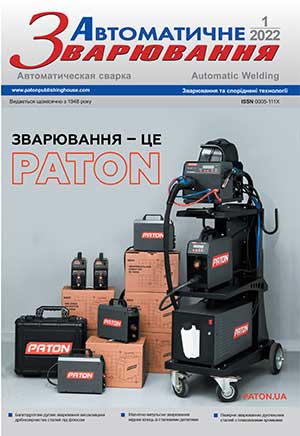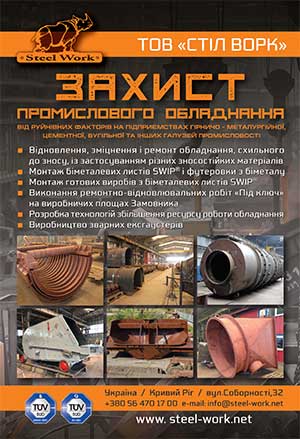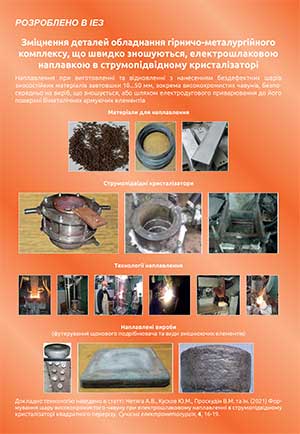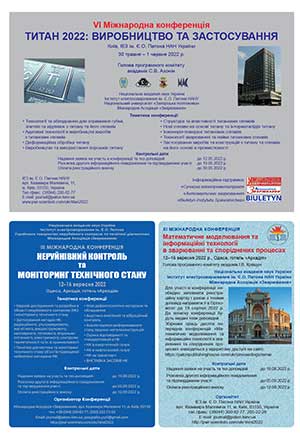| 2022 №01 (02) |
DOI of Article 10.37434/as2022.01.03 |
2022 №01 (04) |
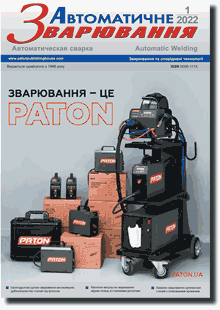
"Avtomatychne Zvaryuvannya" (Automatic Welding), #1, 2022, pp. 22-25
Electron beam welding of aluminum 1570 alloy and mechanical properties of its joints at cryogenic temperatures
V.V. Skryabinsky1, V.M. Nesterenkov1, A.V. Mikitchik2
1E.O. Paton Electric Welding Institute of the NAS of Ukraine. 11 Kazymyr Malevych Str., 03150, Kyiv, Ukraine. E-mail: office@paton.kiev.ua
2SE «International Center for Electron Beam Technologies of the E.O. Paton Electric Welding Institute of the NAS of Ukraine». 03150, Kyiv, 68 Antonovych Str.
The features of electron beam welding of 1570 alloy were studied and mechanical properties of its welded joints in the temperature range of 20...293 K were investigated. It was found that during electron beam welding in the 1570 alloy, the width of the heat-aff ected-zone does not exceed 4 mm from the fusion line, which is 4 times lower than in the AMg6N alloy. In the weld, fusion zone and crack HAZ, accumulation of eutectic layers and other defects were not detected. The ultimate strength of the joints of the 1570 alloy at a decrease in the test temperature from 293 to 20 K increases from 325 to 525 MPa. The conditional yield strength is also increased from 210 to 270 MPa, and the ductility changes slightly. At the same time, the impact toughness decreases from 38 to 9 J/cm2. The coeffi cient of strength of welded joints with a decrease in the test temperature from 293 to 20 K increases from 0.85 to 0.95. In general, the 1570 alloy is well welded by electron beam and the method of electron beam welding can be recommended in the manufacture of welded structures of rockets and spacecrafts. 6 Ref., 1 Tabl., 7 Fig. Key words: electron beam welding, aluminum alloy, mechanical properties, welded joints, cryogenic temperatures
Received: 04.11.2021
References
1. Ovchinnikov, V.V. (2017) Prospects of development of high-technological wrought aluminium alloys for welded structures. Pt 3. Mashinostroenie i Inzhenernoe Obrazovanie, 4, 44-60 [in Russian]. https://old.mospolytech.ru/mio/ rus_1547816839.pdf2. Filatov, Yu.A. (2014) Alloys of Al-Mg-Sc system as a special group of wrought aluminium alloys. Tekhnologiya Lyogkikh Splavov, 2, 34-41 [in Russian].
3. Panteleev, M.D., Bakradze, M.M., Skupov, A.A. et al. (2018) Technological peculiarities of fusion welding of aluminium alloy V-1579. Aviats. Materialy i Tekhnologii, 3(52), 11-17 [in Russian]. https://journal.viam.ru/en/system/fi les/uploads/ pdf/2018/2018_3_2_1.pdf https://doi.org/10.18577/2071-9140-2018-0-3-11-17
4. Nesterenkov, V.M., Skryabinskyi, V.V., Rusynyk, М.О. (2021) Eff ect of thermal cycles in electron beam welding of aluminum 1570 alloy on mechanical properties of welded joints. The Paton Welding J., 5, 35-40. DOI: https://doi. org/10.37434/as2021.05.06 https://doi.org/10.37434/tpwj2021.05.06
5. Koryagin, Yu.D., Iliin, S.I. (2017) Peculiarities of recrystallization of wrought aluminium-magnesium alloys with scandium. Vestnik YuUrGU, Metallurgiya, 17(1), 65-72 [in Russian]. https://cyberleninka.ru/article/n/osobennostirekristallizatsii- deformiruemyh-alyuminiy-magnievyhsplavov- so-skandiem/viewer https://doi.org/10.14529/met170108
6. Bondarev, A.A., Skryabinsky, V.V. (1985) Infl uence of technological factors on softening zone of AMg6NN alloy in electron beam welding. Avtomatich. Svarka, 3, 40-42 [in Russian].
Advertising in this issue:
The cost of subscription/purchase order journals or individual articles
| Journal/Currency | Annual Set | 1 issue printed |
1 issue |
one article |
| TPWJ/USD | 384 $ | 32 $ | 26 $ | 13 $ |
| TPWJ/EUR | 348 € | 29 € | 24 € | 12 € |
| TPWJ/UAH | 7200 UAH | 600 UAH | 600 UAH | 280 UAH |
| AS/UAH | 1800 UAH | 300 UAH | 300 UAH | 150 UAH |
| AS/USD | 192 $ | 32 $ | 26 $ | 13 $ |
| AS/EUR | 180 € | 30 € | 25 € | 12 € |
| SEM/UAH | 1200 UAH | 300 UAH | 300 UAH | 150 UAH |
| SEM/USD | 128 $ | 32 $ | 26 $ | 13 $ |
| SEM/EUR | 120 € | 30 € | 25 € | 12 € |
| TDNK/UAH | 1200 UAH | 300 UAH | 300 UAH | 150 UAH |
| TDNK/USD | 128 $ | 32 $ | 26 $ | 13 $ |
| TDNK/EUR | 120 € | 30 € | 25 € | 15 € |
AS = «Automatic Welding» - 6 issues per year;
TPWJ = «PATON WELDING JOURNAL» - 12 issues per year;
SEM = «Electrometallurgy Today» - 4 issues per year;
TDNK = «Technical Diagnostics and Non-Destructive Testing» - 4 issues per year.






